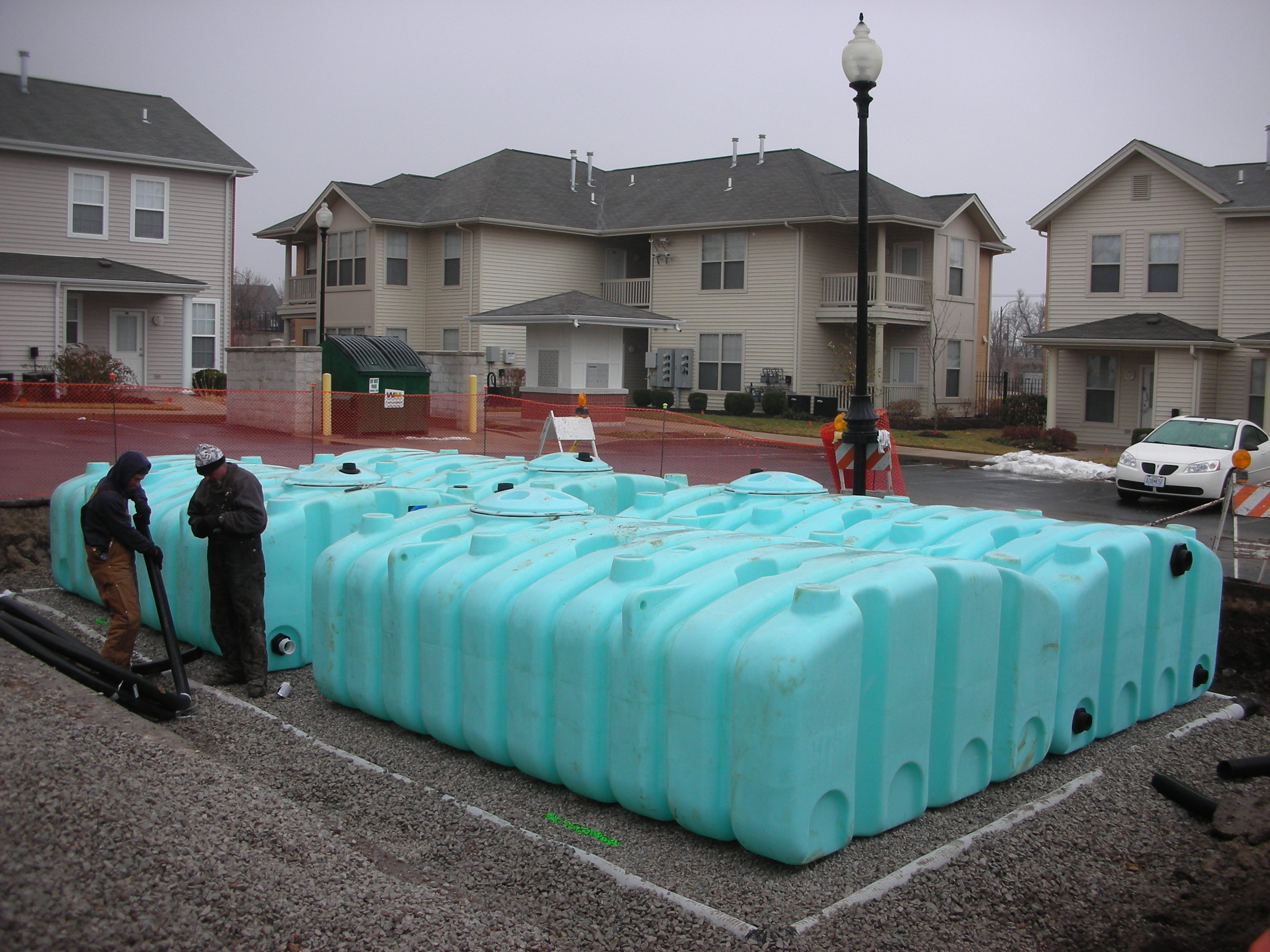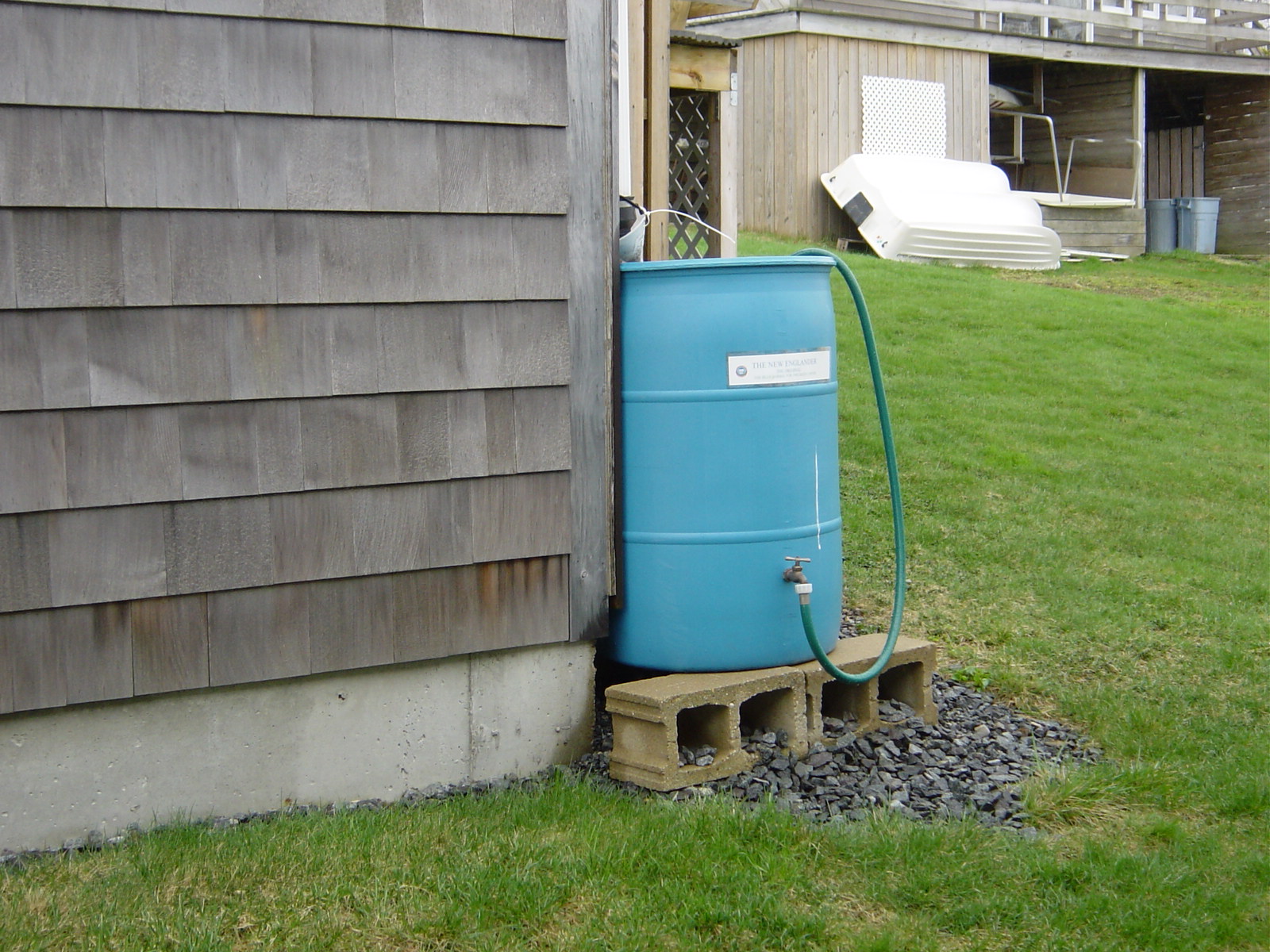Cisterns and Rain Barrels

Description
Cisterns and rain barrels are simple techniques to store rooftop runoff and reuse it landscaping and other nonpotable uses. They are based on the idea that rooftop runoff should be treated as a resource that can be reused or infiltrated. In contrast, conventional stormwater management strategies take rooftop runoff, which is often relatively free of pollutants, and send it into the stormwater treatment system along with runoff from paved areas.
The most common approach to roof runoff storage involves directing each downspout to a 55-gallon rain barrel. A hose is attached to a faucet at the bottom of the barrel and water is distributed by gravity pressure. A more sophisticated and effective technique is to route multiple downspouts to a partially or fully buried cistern with an electric pump for distribution. Where site designs permit, cisterns may be quite large, and shared by multiple households, achieving economies of scale. Stored rain water can be used for lawn irrigation, vegetable and flower gardens, houseplants, car washing, and cleaning windows. When rain barrels or cisterns are full, rooftop runoff should be directed to drywells, stormwater planters, or bioretention areas where it will be infiltrated.

Applications and Design Principles
Cisterns and rain barrels are applicable to most commercial and residential properties where there is a gutter and downspout system to direct roof runoff to the storage tank. They take up very little room and so can be used in very dense urban areas. Rain barrels and cisterns are excellent retrofit techniques for almost any circumstance.
Rain barrels are 50-100 gallon covered plastic tanks with a hole in the top for downspout discharge, an overflow outlet, and a valve and hose adapter at the bottom. They are used almost exclusively on residential properties. Since rain barrels rely on gravity flow, they should be placed near, and slightly higher than, the point of use (whether a garden, flower bed, or lawn.) The overflow outlet should be routed to a dry well, bioretention area, or rain garden. It is important for property owners to use the water in rain barrels on a regular basis, or else they fill up and no additional roof runoff can be stored. It is recommended that each house have at least two rain barrels; a one inch storm produces over 500 gallons of water on a 1000 square foot roof.
Cisterns are partially or fully buried tanks with a secure cover and a discharge pump; they provide considerably more storage than barrels as well as pressurized distribution. Cisterns can collect water from multiple downspouts or even multiple roofs, and then distribute this water wherever it needs to go through an electric pump. Property owners may use one large tank or multiple tanks in series. Either way, the overflow for the systems should be a drywell or other infiltration mechanism, so that if the cistern is full, excess roof runoff is infiltrated, and not discharged to the stormwater system. Some cisterns are designed to continuously discharge water at a very slow rate into the infiltration mechanism, so that the tank slowly empties after a storm event, providing more storage for the next event.
Benefits and Effectiveness
- Rain barrels and cisterns can reduce water demand for irrigation, car washing, or other nonpotable uses. Property owners save money on water bills and public water systems experience lower peak demand and less stress on local water supplies.
- Property owners who have cisterns and rain barrels can use stored water for landscape purposes, even during outdoor watering bans.
- If installed and used properly, rain barrels and cisterns can reduce stormwater runoff volume through storage, and will also help to reduce the peak discharge rate.
Limitations
- The stormwater volume/peak discharge rate benefits of cisterns and rain barrels depend on the amount of storage available at the beginning of each storm. One rain barrel may provide a useful amount of water for garden irrigation, but it will have little effect on overall runoff volumes, especially if the entire tank is not drained in between storms.
- Greater effectiveness can be achieved by having more storage volume and by designing the system with a continuous discharge to an infiltration mechanism, so that there is always available volume for retention.
- Rain barrels and cisterns offer no primary pollutant removal benefits. However, rooftop runoff tends to have few types of sediment and dissolved minerals than municipal water and is ideal for lawns, vegetable gardens, car washing, etc.
- Rain barrels must be childproof and sealed against mosquitoes.
- The water collected is for nonpotable uses only.
Cost
The cost of rooftop runoff storage varies widely, from a homeowner-installed rain barrel to a commercially constructed underground cistern vault. Most rain barrels and cisterns do not retain enough stormwater to downsize the site’s stormwater management system, but can provide cost savings because they reduce the demand for potable water for landscaping and irrigation. The cost-benefit ratio will depend on how much landscaping/irrigation water the property owner uses, and the unit cost of water from the local public water supply.
Commercially available rain barrels begin at approximately $60 for a 55-gallon barrel. Larger barrels may be available at correspondingly higher prices. Most rain barrels can be installed by homeowners. Rain barrels can be assembled by homeowners for lower cost but some of the parts may be hard to find. Some watershed associations or municipalities offer rain barrels at a discount or provide rebates.
Cisterns are more expensive due to the larger size and multiple "moving parts." Installation of buried cisterns can also be expensive. One system available in Massachusetts (SmartStorm) costs $3000 for an 800 gallon two-tank system complete with pump and drywell structure. A common cistern shared by multiple properties may result in considerable economies of scale because there is only one excavation, one tank or set of tanks, and one pump.
Design Details
- Because of the low pressure of the discharge, rain barrels are most effectively used with a drip irrigation system. Rain barrels should be childproof and se- cured against disturbance by people or animals. Any openings should be sealed with mosquito netting.
- If present, a cistern’s continuous discharge outlet should be placed so that the tank does not empty completely, ensuring water availability at all times, while also providing at least some storage capacity for every storm.
- A diverter at the cistern inlet can redirect the "first flush" of runoff which is more likely to have particulates, leaves, and air-deposited contaminants washed off the roof.
- Minimize leaves and debris in the storage tank by placing a screen at the top of the downspout.
- Screen rain barrels and exposed cisterns with shrubs or other landscaped features.
- Direct overflow from rain barrels and cisterns to a dry well, infiltration trench, rain garden, bioretention area, or grassed swale sized to infiltrate the overflow volume. Use pond routing to account for retention of early runoff in the storage tank. Massachusetts Stormwater Management Standards does not require treatment of most roof runoff prior to infiltration.
Additional Information
http://www.rainwaterrecovery.com/about.html www.crwa.org (Charles River Watershed Association)